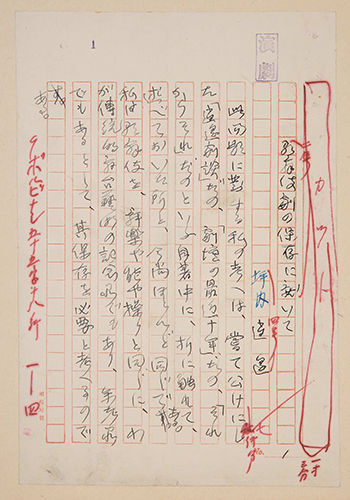10 Japanese

Shōyō wrote the manuscript “On the Preservation of Kabuki Drama” in late March 1924 at the request of Yamamoto Yūzō, the editor of Engeki shinchō, and the essay was published in the journal in June of that year. In his essay, Shōyō addresses what had become for him, by the 1920s, a seminal problem: kabuki was treated as a single art (like nō theater) but, Shōyō felt, the dramatic form had changed significantly over time, from its origins in the early seventeenth century through the early twentieth century. Thus before one could address how to preserve kabuki one needed to determine which aspects of the dramatic art ought be preserved as most representative. Shōyō’s own stance was clear: the “zenith” of the art was in the late eighteenth century and what followed — from the early 19th century onward — was a gradual decay. Thus preservation was perhaps not the right word since what Shōyō sought was really to revive the form of kabuki that had disappeared already over a century earlier.
Shōyō had developed an interest in questions related to the preservation (hozon) of kabuki in the late 1880s and it would remain a concern across his career as playwright, critic, and historian of drama. And yet the timing of “On the Preservation of Kabuki Drama” is also interesting from a historical perspective. The piece was written just six months after the Great Kantō Earthquake destroyed large sections of the city of Tokyo and many writers — Akutagawa Ryūnosuke chief among them — lamented the loss of cultural heritage that resulted from the earthquake and resulting fires. When the earthquake hit on September 1, 1923, Shōyō was at Waseda University in a meeting with Takata Sanae, the University’s president, discussing an exhibition of theater material that was to be held in October. Within days of the earthquake, Shōyō had decided to donate his own private collection of books and theater ephemera to Waseda, the university at which he had taught his entire career. In 1928, with the help of students, friends, and the university, Shōyō was able to realize his long-term goal of creating a theater museum on the campus of Waseda University. The Museum was intended “preserve, as a form of history, Japan’s theater which is incomparable in form in the world and which has developed along a unique path.” Thus while Shōyō may not have achieved his idea of preserving kabuki of the late eighteenth century as a living dramatic art, today the Waseda University Tsubouchi Memorial Theater Museum plays a critical role in preserving the history of kabuki through an unparalleled collection of archival materials.
Contribution by Toshie Marra & Jonathan Zwicker
Librarian for Japanese Collection, C. V. Starr East Asian Library
Associate Professor, Department of East Asian Languages & Cultures
Title in English: On the Preservation of Kabuki Drama
Author: Tsubouchi, Shōyō 坪内逍遥, 1859-1935
Imprint: Atami, Japan, 1924. 14 leaves. Hand-written manuscript. From UC Berkeley Library (accession number: JMS 1474, East Asian Rare)
Language: Japanese
Language Family: Japonic
Source: The Digital Humanities Center for Japanese Arts and Cultures (DH-JAC) at Ritsumeikan University
URL: http://www.dh-jac.net/db1/books/results1024.php?f1=UCB-ms1474&f12=1&enter=berkeley&max=1&skip=2&enter=berkeley
Other related print editions at Berkeley and online:
- Waseda University Tsubouchi Memorial Theater Museum: https://www.waseda.jp/enpaku/en/
- Tsubouchi, Shōyō, 1859-1935. Tōsei shosei katagi: ichidoku santan 当世書生気質: 一読三歎 . [The Characters of Today’s Students]. Tokyo: Banseidō, 1885-1886. 17 volumes. Digital images made available by the National Diet Library: https://dl.ndl.go.jp/info:ndljp/pid/887426 (v. 1)
- Author’s original sketch of the illustration for this work is made available by Waseda University Library:
- Tsubouchi, Shōyō, 1859-1935. Shōsetsu shinzui 小説神髄. [The Essence of the Novel]. Tokyo: Shōgetsudō, 1887. 2 volumes. Digital images made available by the National Diet Library: http://dl.ndl.go.jp/info:ndljp/pid/987668
- UC Berkeley’s copy available for use at the EAL.
- Note: UC Berkeley has later editions of this work for use at the East Asian Library (EAL):
- 1886 ed.: https://search.library.berkeley.edu/permalink/01UCS_BER/iqob43/alma991004564349706532
- 1887 ed.: https://search.library.berkeley.edu/permalink/01UCS_BER/iqob43/alma991004564309706532
- 1888 ed.: https://search.library.berkeley.edu/permalink/01UCS_BER/iqob43/alma991004564269706532
- 1889 ed.: https://search.library.berkeley.edu/permalink/01UCS_BER/iqob43/alma991004564179706532
- 1892 ed.: https://search.library.berkeley.edu/permalink/01UCS_BER/iqob43/alma991004564089706532

